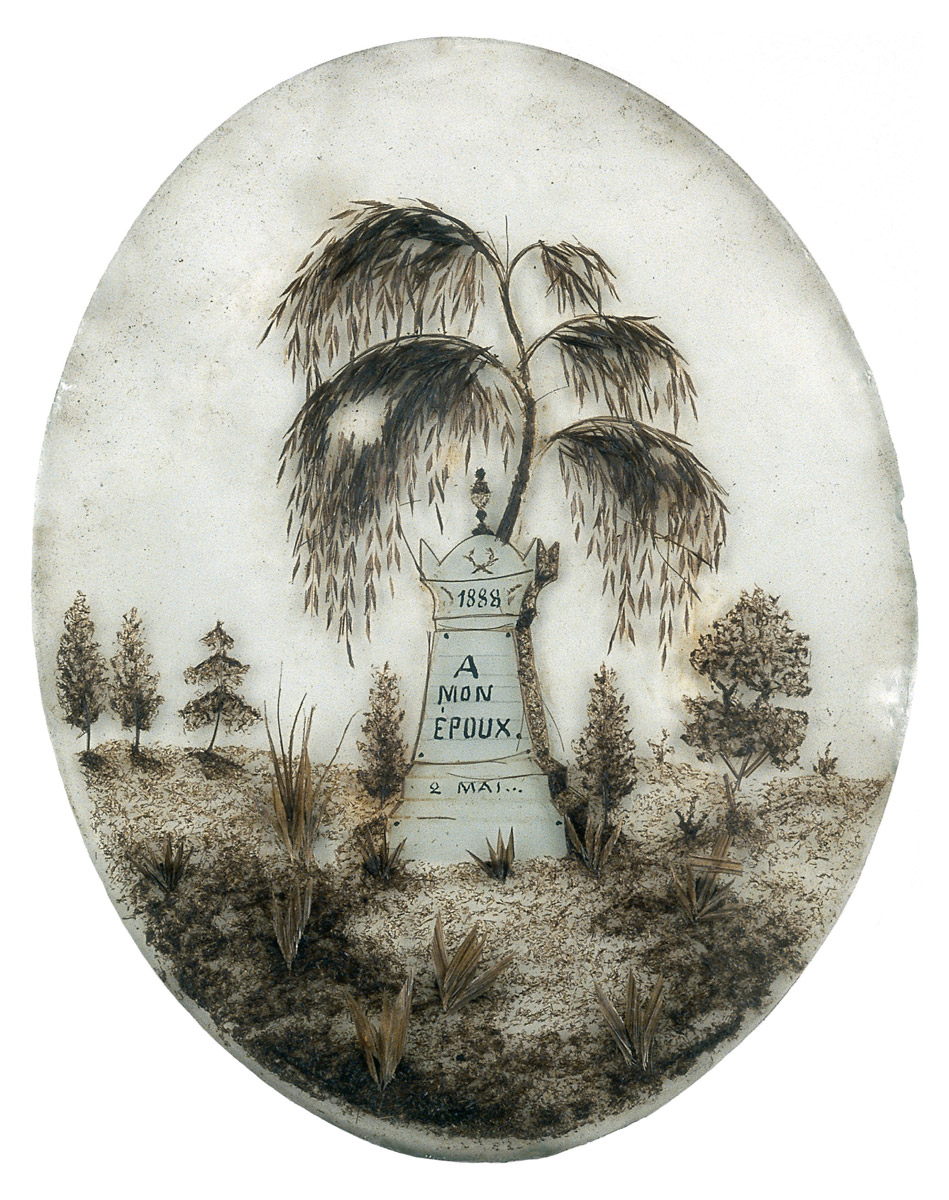Leftovers / Love Locks
Amorous hair jewelry
Deborah Lutz
“Leftovers” is a column that investigates the cultural significance of detritus.
In place of a gemstone, Edward, in Jane Austen’s Sense and Sensibility, sets his ring with “a plait of hair in the centre.”[1] The secret identity of this tress, the lies and clandestine intimacies it bespeaks, fuel the central love narrative, making desire and all its consuming emotions material in this single curl. Hair jewelry as a figure of amorous adventure abounds in nineteenth-century literature and letters. Heathcliff, in Emily Brontë’s Wuthering Heights, in saying goodbye to Catherine just after her death, removes Edgar Linton’s pale hair from her locket and replaces it with his own heavy black crop. Byron and his half-sister Augusta, in a display of hidden audacity, attested to their affair by wearing gold brooches inset with locks of each other’s hair and inscribed with the other’s initials, along with three incised crosses—their secret sign for sexual consummation. The only clue to the identity of the lovely, orphaned Mary in Wilkie Collins’s Hide and Seek is a hair bracelet that affirms, twenty-odd years after the fact, an amorous tryst which ruins the lives of many.

Hair objects were made at home or purchased through mail order companies such as, in the US, Sears and Roebuck. In the mid-nineteenth century, the American journal Godey’s Lady’s Book carried advertisements for the manufacture of hair jewelry; one could mail in a lock of hair and have made brooches, earrings, bracelets, rings, watch fobs, and sleeve buttons. Scandals sometimes erupted when it was alleged that a stranger’s hair might be substituted for that of the beloved, or that too much horsehair would be mixed in to stiffen the weave. Hairwork also became a popular drawing room pastime, and Godey’s Lady’s Book and Peterson’s Magazine printed hairwork columns where readers could learn to boil and weave hair themselves, as well as discover new patterns and fashions in hair jewelry. Instructional books, such as Mark Campbell’s 1865 Self-Instruction in the Art of Hair Work, described how to use round tables with a series of weights to be attached to the strands to be woven, which could also be ordered through the mail.
Nineteenth-century landscapes with clouds fashioned from bits of human hair and pasted on a painted blue sky, or weeping willows woven from curled tresses, may strike the modern observer as exotic, slightly morbid curios. Today, hair no longer connected to the head needs to be cleaned up—picked out of the shower drain, swept from the salon floor. Hair’s dirtiness comes from its association with flaking skin, the leavings of a corpus that grows only to shed its ornaments with slow decay. But in nineteenth-century England and America, this very materiality of cut hair often acted as an amorous contract, a sensual promising of the body. While hairwork was often used as mourning jewelry, made from hair cut from the corpse of the beloved, it was also used as a token of love, pointing to an amorous past, and possibly a future agreement. Again in Sense and Sensibility, illicit engagement illuminates this synecdoche. Marianne commits herself to Willoughby, an as-yet undisclosed rake, by giving him a lovelock. This fragment of herself then stands, contractually, as undeniably as a signature or fingerprint. “I am sure,” Marianne’s younger sister Margaret says, “they will be married very soon, for he has got a lock of her hair.”[2]
A writer for Godey’s Lady’s Book comments that hair is “at once the most delicate and lasting of our materials and survives us like love.”[3] Hair endures, the Victorians felt, like vowed fidelity. One type of amorous ring displays the hair behind a movable gem, which, when slid aside, exposes the plait. This contrast of textures touches the attraction of preserved hair. Culled from the source in the midst of an active love, hair jewelry enshrines the body in its most mysterious states: fragmentation, stillness, and absence. When other recognizable parts, the flesh and eyes, have decayed, the hair abides to testify to the unique whole. In fact, hair continues to grow on a corpse after death, and its appeal as a memento arises from the combination of its luxurious changeability, threadlike fragility, and paradoxical durability. The personal time of the body is marked by looking at the hairstyles of old photographs; hair may be the part of the body most susceptible to dating discrete periods of our existence. It holds its color, shape, and texture when divided from its source, and continues to attest to the era from which it comes: the soft, pale baby lock, the shiny, rich adult head, and the grizzled grey of old age.
Like a photograph, hair indexically points to the singular moment of a past existence, intractably gone. Both a plait of hair and a photograph derive meaning from their referents, and from the irretrievability of these referents toward which the artifacts endlessly, if mutely, gesture. Always retained in hairwork is the subject made object through the reverie of sentimental labor on the part of the bereaved, an allegory of death (even sexual promises bound with locks of hair connote a deathliness, an absence). Roland Barthes’s theory of the photograph as ineluctable evidence of the being of the beloved thus applies also to hairwork—a lock of hair speaks of the undeniable “that has been” of the lover. The pathos of studying nineteenth-century hairwork today, now divorced from its meaning and context, remains the assured death of its referent—now not only the particular person, but the larger cultural practice of deathbed memorials and women’s fine handiwork as a way to structure and memorialize mourning itself.
- Jane Austen, Sense and Sensibility (New York: Penguin, 1995), p. 86.
- Ibid., p. 53.
- “Hair Ornaments,” Godey’s Lady’s Book (1860), p.187.
Deborah Lutz teaches literature at Hunter College and writes on Victorian erotica and the popular romance.